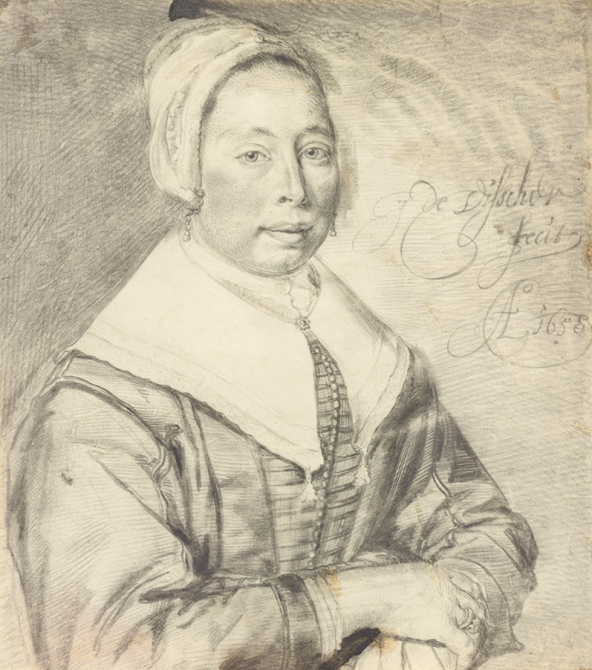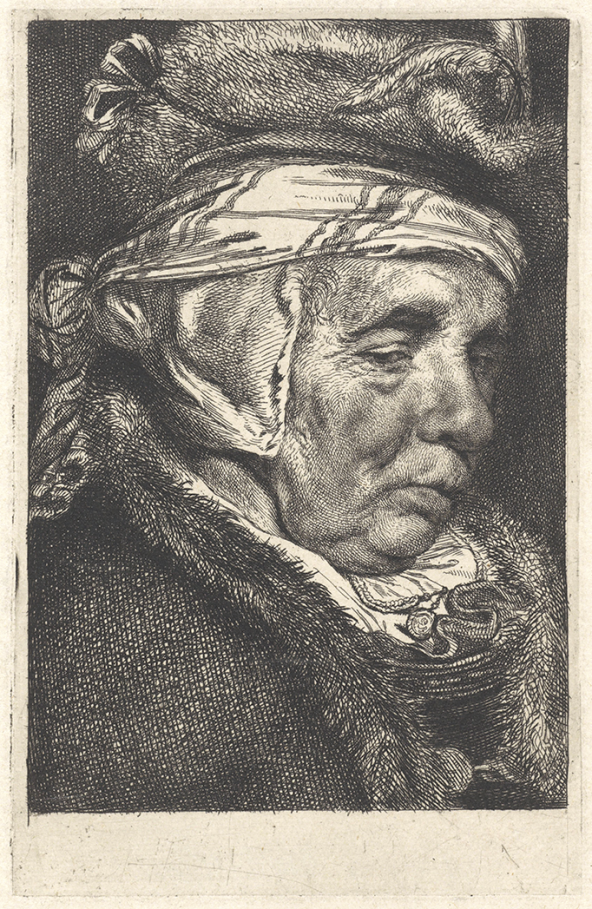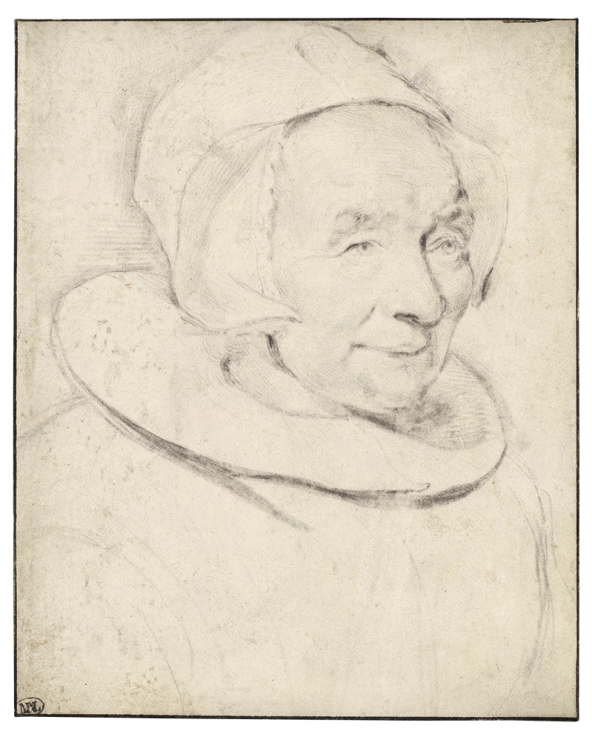Choose a background colour
Jan de Visscher, Dutch, 1633/34 -1712
:
Portrait of an Old Woman, c. 1658-60
Black chalk on vellum.
5 13⁄16 × 4 7⁄8 in. (14.8 × 12.4 cm)
Recto, upper right, in black chalk, signed by the artist, Vissche (partially cut off); verso, upper left, in pencil, M4, lower left in graphite, 9/-/-.
- Chain Lines:
- None.
- Watermark:
- None.
- Provenance:
Possibly Johann Heinrich Beck, 1788 – 1875, Dessau; his sale, Hollstein & Puppel, Berlin, 27 – 29 March 1922, lot 1423; Karel Emil (aka Charles) Duits, 1882 – 1969, London (Lugt 533a); sale, Sotheby’s, London, 8 July 1998, lot 57; Sheldon and Leena Peck, Boston (Lugt 3847); gift to the Ackland Art Museum, inv. no. 2017.1.94.
- Literature/Exhibitions:
Hawley 2015, 295 – 96, no. R – 95.
- Ackland Catalogue:
- 2017.1.94
Although a printmaker by profession, Jan de Visscher made a number of portrait drawings in the late 1650s before turning entirely to printmaking in the 1660s. For this unidentified sitter, De Visscher skillfully applied black chalk on vellum to softly model the older woman’s dignified countenance and informal dress. This sensitive portrayal is one of only nineteen drawings known by the artist today, making it a rare and significant work.
This portrait offers us an exceptional glimpse into the personality of an older seventeenth-century woman. Dignified yet informal, she appears without the trappings of pretense common to portraiture in the era, yet possesses a countenance clearly etched with a contentedness and gravitas that only comes with age. That such a nuanced and animated likeness was long considered a work of one of the most celebrated portrait draftsmen of the seventeenth century, Cornelis Visscher (1628/29 – 1658), comes as no surprise. Trained as a printmaker, Cornelis left behind a corpus of 185 prints and over 100 drawings before dying prematurely around the age of twenty-nine.1
The Peck drawing, however, turns out to be a rare and significant work by his equally talented younger brother, Jan de Visscher. Likewise a printmaker by training and occupation, his smaller and much lesser-known corpus of drawings has only recently been elucidated.2
Only around eighteen drawings by Jan de Visscher have come to light, to which the present work can be added.
John Hawley, who catalogued the drawings of both brothers, confirmed the new attribution of the present work to Jan de Visscher.3
Hawley’s work in separating the oeuvres of Jan and Cornelis was no small feat, since so many of Jan’s drawings (not just this one) were long assumed to be the work of Cornelis. Some even bear forged signatures, with Jan’s first initial J. changed to a C., an alteration which could have taken place in the eighteenth century, a period when Cornelis’s drawings were so highly esteemed they could reach higher prices than those of Rembrandt (1606 – 1669) or Rubens (1577 – 1640).4
Drawings like this one simply bear a signature of Visscher without a first letter. Jan began to sign this way after Cornelis’s death in January 1658, when he no longer felt it necessary to make a distinction between his and his brother’s works.5
The orthography of the name in this case also matches those in the “Visscher Group” (meaning those signed without a first initial or name), a term Hawley applied to the eight other drawings belonging to Jan with the same signature.6
The brothers’ continuity of styles in their drawings from the late 1650s nevertheless remains striking. This is not entirely surprising since they drew from the same models together. Jan appears to have intently studied Cornelis’s technique, mastering his ability to softly modulate forms with great control and yet seamlessly integrate a certain amount of swift line work to keep the image animated. Nevertheless, one can detect slight differences in their approach. A signed drawing of a woman by Jan de Visscher in the J. Paul Getty Museum dated 1658 reveals a similar treatment of certain facial features and the loose manner of representing the smooth and coruscating textures of her mantle and dress Fig. 52.1.7

Jan de Visscher, Portrait of a Woman Wearing a Bonnet, with Her Hands Crossed, 1658. Black chalk, with touches of pen and black ink (probably added later), on vellum, 202 × 178 mm. Los Angeles, J. Paul Getty Museum, inv. no. 2004.57.
The J. Paul Getty Museum, Los Angeles
A comparison of the two artists’ portrait drawings also reveals Jan’s tendency to represent his sitters in a more relaxed (or at least less piercing) manner than Cornelis, which at once makes them more personable and, arguably, better apprehended as individuals. Jan executed most of these drawn portraits in the few years after Cornelis’s death, a period during which the Peck drawing can also be assigned. Jan appears to have shifted his attention entirely to printmaking in the 1660s, a decade from which no drawings by him are known, and only made a few other portrait drawings later in life. He perhaps sought to fill the demand for such finely rendered portrait drawings in the first few years after his brother’s sudden death.8
These works evince Jan’s own considerable powers as a portraitist, and it is a shame that he did not produce more.
As with so many portrait drawings by the Visscher brothers, the identity of the sitter remains a mystery. The seemingly intimate nature of the portrayal of this woman might suggest that she was a family member of the Visschers’, or someone close to them, but such assumptions can prove fraught. This woman bears no resemblance to the so-called “Visscher’s mother” etching by Cornelis, which was almost certainly intended as a tronie, or a sort of character study rather than a portrait Fig. 52.2.9

Cornelis Visscher, Head of an Old Woman (the so-called “Visscher’s mother”). Etching, 143 × 92 mm. Amsterdam, Rijksmuseum, inv. no. RP-P-OB-27.439.
Rijksmuseum, Amsterdam
The present work was previously described as a tronie as well, a description likely based on the woman’s outward glance, as opposed to looking directly at the viewer, a far more common pose at the time.10
There are exceptions to this rule, however. Her dignified aspect and the vellum support both strongly indicate a portrait function. The same woman is depicted in a drawing in the Louvre, a work that at first glance appears to be a loose copy Fig. 52.3.11

Possibly Jan de Visscher (or copy after), Portrait of an Old Woman, c. 1658 – 60. Black chalk on vellum, 125 × 101 mm. Paris, Musée du Louvre, inv. no. 23119.
RMN-Grand Palais/Art Resource, NY
Its liveliness, however, especially around the eyes, and certain other differences suggest it was a preparatory study or even a vidimus to show to the sitter in advance of the final work. The three-quarter view of her face would have been unusual at the time, and intentionally reminiscent, perhaps, of an older style of portraiture.
End Notes
For Cornelis Visscher, see Hawley 2015, which includes a catalogue of his drawings.
See Hawley 2014 for Jan de Visscher’s drawings.
Email correspondence with the author, 28 June 2021.
Hawley 2014, 72.
Hawley 2014, 75 – 81. The form of the signature on the present drawing led to Hawley’s initial suggestion that it might be the work of Jan instead of Cornelis, whose authorship he rejected (see Hawley 2015, 295 – 96, no. R – 95) based on an auction catalogue photo.
For the orthography of the signature, see Hawley 2014, 79. Hawley notes that Jan de Visscher apparently only signed his surname with a long s followed by a short one (the form found on the present drawing) in the years 1658 – 59, thus just after the death of Cornelis. His brother had signed in the same way, then later adopted a form with both being long. For the other drawings in the Visscher Group, see idem, 83 – 84, nos. B1 – B8.
Hawley 2014, 82, no. A2.
Hawley 2014, 81; see also idem, 94 (note 66) for comments about Jan potentially asserting a sort of “brand identity” just after Cornelis’s death by signing Visscher without a first initial.
Hollstein, vol. 40, no. 171.
The drawing was listed under the category of tronies in Hawley 2015, 295 – 96, no. R – 95.
Hawley 2015, 296, no. R – 96.
